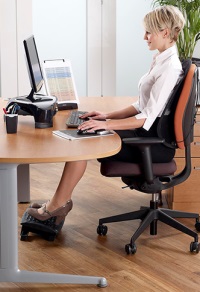Laptops give you HOLS (Hunched Over Laptop Syndrome) and tablets are a pain in the neck

Most British office workers — 79 percent — say that working with mobile devices such as laptops and tablets is making them sick, according to a research conducted on behalf of Fellowes. The problem even has a catchy name: HOLS, for Hunched Over Laptop Syndrome.

Decades of ergonomics research led to workstation designs and working practices intended to reduce the ill effects of poor posture in the workplace. In the UK, this resulted in the HSE's Display Screen Regulations, which came into force in 1992. With the move to laptops, tablets, and mobile working, most of these ideas seem to have been forgotten. In fact, the situation may well be getting worse, because more people are using laptops inside as well as outside the office.
Dr Sarah Jarvis, a general practitioner and health broadcaster (for The One Show) commented: "Permanent desk spaces are the thing of the past, with many of us working in a nomadic style. In many cases, this so-called HOL syndrome is brought on by lack of ergonomic equipment. Job illnesses and ailments associated with poor posture are rising significantly, and I am seeing more in my practice year on year."
Fellowes, a company that sells ergonomic office equipment, claims that "the lack of specialist ergonomic equipment when on the move is the prime cause for the rise in work-related back and joint injuries brought on by devices that promise to make our lives easier". It claims that equipment-related problems (including unergonomic desks and chairs) cost UK companies £7.2 billion a year.
The self-interest is obvious, but the company does have a point. Its research found that 25 percent of workers say their posture is worse when they work nomadically with handhelds, tablets, and laptops, and about 10 percent say this type of working has caused long-term problems. Back pains and upper limb disorders often result in people taking time off work, and a "staggering" 5 percent have been forced to give up their job altogether, said Fellowes.
Problems typically arise after many years of bad posture, but the report says younger workers aged 18 to 24 were the "most seriously affected". Two thirds claim to have a problem caused by mobile working.
The research was undertaken for Fellowes by Dynamic Markets among 1,000 UK adults aged 18 or over.
Minimizing the pain
The laptop problem has been recognised for many years, and I'm one of the people who has suffered from it (see: When laptops are a pain in the neck). The standard advice is to follow the practices adopted for desktops and workstations. For example, the top of the screen should be roughly level with your eyes. This means either using a separate monitor, or putting the laptop on a riser and using a separate keyboard and mouse. You can then sit in a more upright position, which is good for the spine.
Tablets may be even more dangerous, and many people are already suffering from "iPad neck". There has not been much research into the ergonomic use of tablets for work, but Dr Jack Dennerlein and colleagues at the Harvard School of Public Health have done a study with 15 subjects, and confirmed that looking down at a tablet causes problems.
Dr Sarah Jarvis suggests following the laptop rules when using an iPad. "Treat it as a mobile computer," she said. "I've got a stand for my iPad." You can look down, but "avoid the 'vulture posture', which is particularly bad for your back".
To minimise the risk of injury when using tablets and laptops, try to keep your spine fairly straight, change your posture frequently, and take regular screen breaks. (Get up and move around.) With desktop PCs, you should take a break every hour. When working on a laptop, take a 5-minute break every 30 minutes or less. When working on a smartphone, take a break after 10 to 15 minutes.
If you don't think this stuff is important, you should know that your spinal inclination is the best predictor of whether you will end up in a nursing home, or in need of daily home care. See Posture Provides Clue for Future Disability in The Gerontological Society of America (GSA) journal.